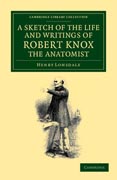
Among the ablest anatomical teachers of his day, Robert Knox (1791–1862) also busied himself with the study of zoology and ethnology. Prepared by his pupil and colleague Henry Lonsdale (1816–76), this 1870 biography explores the scope of Knox's scientific research and the nature of his character. It describes how Knox developed at Edinburgh one of the most significant anatomical schools in Britain, playing a dominant role in expanding the comparative anatomy collection held by the city's Royal College of Surgeons. Despite his eminence and popularity as a lecturer, his reputation was deeply tarnished by his association with the notorious murderers Hare and Burke, who had provided Knox with bodies for dissection. Drawing on surviving correspondence and information gathered from friends and colleagues, Lonsdale's work stands as a robust defence and sympathetic portrait of a prominent yet controversial figure in the history of nineteenth-century medicine. INDICE: Preface; 1. The Knox family; 2. Contributions to the Wernerian Society; 3. Obstacles to anatomy; 4. Hare and Burke; 5. Knox ill treated by the profession; 6. Knox in danger; 7. Knox's personality and showy attire; 8. Comparative and general anatomy; 9. Great northern and young whalebone whales; 10. Salmon, herring, and vendace; 11. The chair of pathology; 12. Life at home; 13. The philosophy of anatomy; 14. The Edinburgh physiology chair; 15. The races of men; 16. Races of men (cont.); 17. Congenital deformity of joints; 18. Great artists and great anatomists; 19. Popular physiology; 20. Medical comments on Dr Knox; Index.
- ISBN: 978-1-108-06529-0
- Editorial: Cambridge University Press
- Encuadernacion: Rústica
- Páginas: 448
- Fecha Publicación: 05/09/2013
- Nº Volúmenes: 1
- Idioma:
